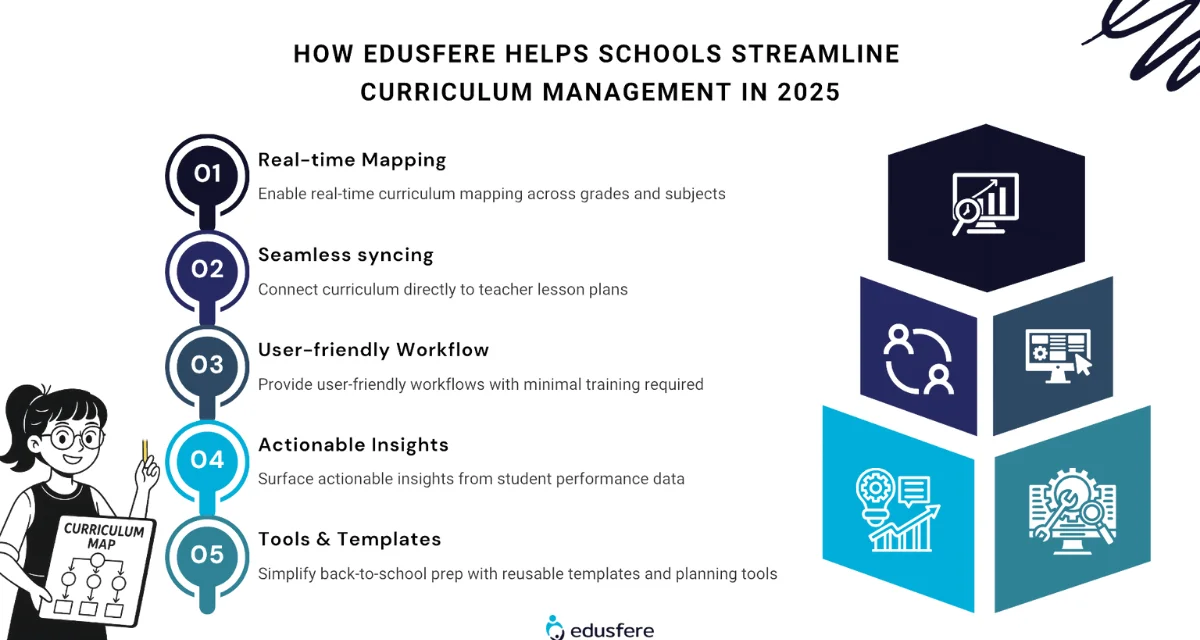Schedule a free demo to learn more
Top 5 Curriculum Management Mistakes Schools Often Make and How to Avoid Them in 2025
13th June 2025

The promise of digital curriculum management is exciting in the dynamic K-12 environment of 2025 but the reality is often far more complex. Many schools invest in technology but fail to see real instructional improvement. Why? Because without the right approach, tools and mindset, even the best curriculum management platforms can fall flat.
With back-to-school prep 2025 in full swing, now is the ideal time for educators and administrators to assess what’s working; and more importantly, what’s not. Below, we explore five of the most common curriculum management missteps schools make and how your institution can avoid them using proven strategies.
1. Treating Curriculum Management Like a Static Document
Many schools upload static files or PDFs into a digital folder system and mistakenly label it “curriculum management.” But true curriculum management involves building a responsive, evolving framework that adapts to standards, assessments and classroom realities.
This static approach leads to fragmented teacher lesson plans, limited transparency and low adaptability. Teachers often fill gaps on their own, causing misalignment and inconsistent learning experiences across classrooms.
Read More: Beyond Spreadsheets- How to Choose the Right Curriculum Mapping Software for Your School
Here’s how you can avoid it:
A McKinsey research report found that K-12 teachers spend an average of 11 hours per week on lesson preparation, grading and administrative tasks but effective use of digital platforms could reduce that to 6 hours, freeing up critical planning and collaboration time.
Invest in a platform designed to treat curriculum as a living ecosystem. Choose tools that allow real-time updates, cross-grade visibility and collaborative planning. A modern solution like Edusfere enables educators to maintain alignment, identify instructional redundancies and improve planning efficiency.
Pro Tip: In order to introduce iterative improvements and ensure agility in planning, schedule quarterly curriculum reviews, not annual ones.
2. Overlooking the link between Curriculum Mapping and Teacher Lesson Plans
Curriculum leaders often focus on district-wide alignment but overlook how curriculum maps trickle down to the classroom. Teachers, especially during back-to-school prep, may receive top-down directives without actionable tools to guide daily lesson planning.
Educators create lesson plans in silos, relying on outdated templates or inconsistent resources. This disconnect erodes alignment with standards and makes it difficult to measure instructional effectiveness.
Here’s how you can address that:
According to EdWeek, over 70% of teachers say they want planning tools that align with standards and reduce workload.
Choose platforms where curriculum mapping and teacher lesson plans are seamlessly integrated. Edusfere enables educators to pull directly from maps into weekly lesson planners, ensuring every classroom activity ladders up to district goals.
3. Choosing overtly complex Curriculum Management Tools
In the rush to go digital, schools sometimes choose platforms packed with features they don’t need or ones with steep learning curves. Without proper onboarding and support, these tools end up becoming shelfware. These lead to educators feeling overwhelmed, revert to spreadsheets and PDFs and the system never gains traction across the district.
Here’s how you can steer clear of it:
The ISTE recommends selecting teacher-friendly platforms with embedded professional learning and a simple UI for long-term adoption.
Also Read: 6 Signs it’s Time to Upgrade your Curriculum Management System
Opt for tools built with educators in mind. The best curriculum management platforms prioritize usability, offer guided onboarding and support real workflows without bloating. With Edusfere, schools get a clean, intuitive interface with embedded learning and real-time collaboration.
In a nutshell, if your staff needs a training manual to navigate the system, it’s too complex.

4. Failing to Use Data to Drive Curriculum Improvements
A study by McGraw Hill found that data-driven curriculum planning can improve core subject performance by up to 25%.
Many schools collect data but fail to apply it to curriculum decisions. Curriculum teams often operate independently of assessment or data teams, missing valuable feedback loops. Learning gaps often go unnoticed, instructional blind spots remain unresolved and strategic planning is driven by assumption rather than evidence.
Here’s how to avoid it:
Choose curriculum management tools that integrate real-time performance data. Edusfere connects curriculum plans with formative and summative assessment outcomes, allowing educators to refine pacing, content and teaching strategies based on actual student needs.
You can begin by setting monthly review cycles where instructional coaches and curriculum teams analyze key data trends and adjust maps accordingly.
5. Lacking a Scalable Curriculum Mapping Strategy for Back-to-School Prep
Each academic year begins with an urgency to align lessons, standards and goals. Without a central curriculum archive or version history, teams scramble to update old files or recreate resources from scratch. Critical learnings are lost, updates go undocumented and new staff spend weeks onboarding without a clear picture of instructional priorities.
Here’s how you can avoid it:
The Christensen Institute notes that resilient schools build infrastructure in advance, not in response to crisis.
Adopt a platform that offers scalable, reusable workflows and cloud-based version control. With Edusfere, teams can clone and customize previous year’s curriculum, maintain historical records and align updates across grade levels, ensuring back-to-school prep 2025 begins with clarity, not chaos.
How Edusfere helps schools streamline Curriculum Management in 2025
At Edusfere, we’re redefining what effective curriculum management looks like for today’s K-12 landscape. Our cloud-based platform is purpose-built for schools looking to:
- Enable real-time curriculum mapping across grades and subjects
- Connect curriculum directly to teacher lesson plans
- Provide user-friendly workflows with minimal training required
- Surface actionable insights from student performance data
- Simplify back-to-school prep with reusable templates and planning tools
Whether you’re preparing for the next quarter, onboarding new staff or gearing up for accreditation, Edusfere helps curriculum teams work smarter, not harder.
Ready to Transform your School’s Curriculum Management?
Schedule a personalized demo with Edusfere today and start the school year with a system built for success.